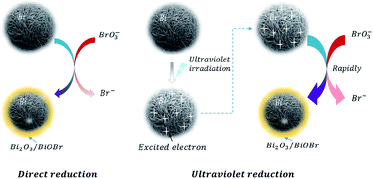A novel zero valent metal bismuth for bromate removal: direct and ultraviolet enhanced reduction†
Abstract
Bromate (BrO3−) is a carcinogenic and genotoxic by-product of the ozone disinfection process. In this study, a new zero-valent metal, bismuth, was used to reduce bromate. Bismuth samples were prepared by a solvothermal method and characterized by powder X-ray diffraction (PXRD), scanning electron microscopy (SEM), and transmission electron microscopy (TEM). The morphology of the bismuth powder was microspheres assembled with dense nanosheets. The kinetics of the direct bromate reduction by bismuth accorded with the pseudo-first-order kinetics model. The rate coefficients of the initial bromate concentration of 1.00 mg L−1, 2.50 mg L−1, 5.00 mg L−1 were identically close to 0.08 min−1. For 0.20 mg L−1, a reaction rate coefficient near 0.10 min−1 was obtained. The reducing products of bromate included bromide ions (Br−) and bismuth oxybromides. The bromate removal efficiency was enhanced remarkably in the presence of ultraviolet (UV) light, and the corresponding kinetic coefficient was 4 times higher than that of direct reduction. The mechanism of ultraviolet enhancement was analyzed by diffuse reflectance spectroscopy (DRS), the density functional theory (DFT) calculation, open circuit potential (OCP) analysis, photocurrent measurement and linear sweep voltammetry (LSV). Besides, the influence of dissolved oxygen (DO) on bromate reduction efficiency and the sustainability of the as-prepared sample were investigated. DO inhibited the reduction rate obviously, but showed a slight effect on the formation of bromide ions. In the long-term periodic experiments, the kinetic coefficient decay occurred in both direct (without UV irradiation) and ultraviolet assisted bromate reduction. However, the kinetic coefficient of UV-assisted reduction (0.115 min−1) was about 2 times higher than that of the direct reduction in the last cycle of periodic experiments. In conclusion, the novel bromate reduction strategy based on the zero-valent bismuth metal material has been proved efficient and sustainable, which contributes to the development of drinking water treatment technologies.



 Please wait while we load your content...
Please wait while we load your content...